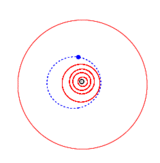(9992) 1997 TG19
|
Orbit of (9992) 1997 TG19 (blue), compared to the inner planets and Jupiter (outermost) | |
| Discovery [1] | |
|---|---|
| Discovered by |
T. Kagawa T. Urata |
| Discovery site | Gekko Observatory |
| Discovery date | 8 October 1997 |
| Designations | |
| MPC designation | (9992) 1997 TG19 |
|
1997 TG19 · 1974 HC1 1980 BD | |
| Mars-crosser [1][2] | |
| Orbital characteristics [1] | |
| Epoch 31 July 2016 (JD 2457600.5) | |
| Uncertainty parameter 0 | |
| Observation arc | 42.15 yr (15,396 days) |
| Aphelion | 2.8051 AU |
| Perihelion | 1.5375 AU |
| 2.1713 AU | |
| Eccentricity | 0.2919 |
| 3.20 yr (1,169 days) | |
| 31.207° | |
| 0° 18m 29.16s / day | |
| Inclination | 2.5945° |
| 42.995° | |
| 234.84° | |
| Earth MOID | 0.5229 AU |
| Physical characteristics | |
| Dimensions |
3.07 km (derived)[2] 4.75±0.36 km[3] |
|
5.7300±0.0016 h[4] 5.7402±0.0005 h[5] 5.7408±0.0009 h[lower-alpha 1] | |
|
0.137±0.022[3] 0.20 (assumed)[2] | |
| S [2] | |
|
14.40[3] 14.48±0.08 (R)[lower-alpha 1] 14.5[1] 14.663±0.004 (R)[4] 14.76±0.26[6] 14.97±0.094[2][7] | |
|
| |
(9992) 1997 TG19 is a stony asteroid and eccentric Mars-crosser, approximately 4 kilometers in diameter. It was discovered on 8 October 1997, by Japanese astronomers Tetsuo Kagawa and Takeshi Urata at Gekko Observatory near Shizuoka, Japan.[8]
The stony S-type asteroid orbits the Sun at a distance of 1.5–2.8 AU once every 3 years and 2 months (1,169 days). Its orbit has a typically high eccentricity of 0.29 and an inclination of 3° with respect the plane of the ecliptic.[1] The first used observation was made at the Cerro El Roble Station in 1974, extending the asteroid's observation arc by 23 prior to its discovery.[8]
Between 2006 and 2013, three rotational light-curves for this asteroid were obtained from photometric observations made at the Hunters Hill Observatory, Australia, the Ondřejov Observatory, Czech Republic, and the U.S. Palomar Transient Factory, California. They gave a well-defined, concurring rotation period of 5.7402±0.0005 hours (best result) with a brightness amplitude of 0.42, 0.40 and 0.27 in magnitude, respectively (U=3/3/2).[lower-alpha 1][4][5]
According to the survey carried out by the Japanese Akari satellite, the asteroid's surface has an albedo of 0.13 and a diameter of 4.75 kilometers.[3] The Collaborative Asteroid Lightcurve Link assumes a standard albedo for stony asteroids of 0.20 and calculates a diameter of 3.1 kilometers, as the higher the body's albedo (reflectivity), the shorter its diameter, at a constant absolute magnitude (brightness).[2]
References
- 1 2 3 Pravec (2006) web: rotation period 5.7408±0.0009 hours with a brightness amplitude of 0.0009 mag. Summary figures at Collaborative Asteroid Lightcurve Link (CALL) for (9992) and Pravec − Results from Asteroid Photometry Project at Ondřejov Observatory
- 1 2 3 4 5 "JPL Small-Body Database Browser: 9992 (1997 TG19)" (2016-06-16 last obs.). Jet Propulsion Laboratory. Retrieved 4 July 2016.
- 1 2 3 4 5 6 "LCDB Data for (9992)". Asteroid Lightcurve Database (LCDB). Retrieved 4 July 2016.
- 1 2 3 4 Usui, Fumihiko; Kuroda, Daisuke; Müller, Thomas G.; Hasegawa, Sunao; Ishiguro, Masateru; Ootsubo, Takafumi; et al. (October 2011). "Asteroid Catalog Using Akari: AKARI/IRC Mid-Infrared Asteroid Survey". Publications of the Astronomical Society of Japan. 63 (5): 1117–1138. Bibcode:2011PASJ...63.1117U. doi:10.1093/pasj/63.5.1117. Retrieved 4 July 2016.
- 1 2 3 Waszczak, Adam; Chang, Chan-Kao; Ofek, Eran O.; Laher, Russ; Masci, Frank; Levitan, David; et al. (September 2015). "Asteroid Light Curves from the Palomar Transient Factory Survey: Rotation Periods and Phase Functions from Sparse Photometry". The Astronomical Journal. 150 (3): 35. arXiv:1504.04041
 . Bibcode:2015AJ....150...75W. doi:10.1088/0004-6256/150/3/75. Retrieved 4 July 2016.
. Bibcode:2015AJ....150...75W. doi:10.1088/0004-6256/150/3/75. Retrieved 4 July 2016. - 1 2 Higgins, David; Pravec, Petr; Kusnirak, Peter; Galad, Adrian; Kornos, Leos; Pray, Donald; et al. (December 2006). "Asteriod lightcurve analysis at Hunters Hill Observatory and collaborating stations - autumn 2006". The Minor Planet Bulletin. 33 (4): 89–91. Bibcode:2006MPBu...33...89H. ISSN 1052-8091. Retrieved 4 July 2016.
- ↑ Veres, Peter; Jedicke, Robert; Fitzsimmons, Alan; Denneau, Larry; Granvik, Mikael; Bolin, Bryce; et al. (November 2015). "Absolute magnitudes and slope parameters for 250,000 asteroids observed by Pan-STARRS PS1 - Preliminary results". Icarus. 261: 34–47. arXiv:1506.00762
 . Bibcode:2015Icar..261...34V. doi:10.1016/j.icarus.2015.08.007. Retrieved 4 July 2016.
. Bibcode:2015Icar..261...34V. doi:10.1016/j.icarus.2015.08.007. Retrieved 4 July 2016. - ↑ Pravec, Petr; Harris, Alan W.; Kusnirák, Peter; Galád, Adrián; Hornoch, Kamil (September 2012). "Absolute magnitudes of asteroids and a revision of asteroid albedo estimates from WISE thermal observations". Icarus. 221 (1): 365–387. Bibcode:2012Icar..221..365P. doi:10.1016/j.icarus.2012.07.026. Retrieved 4 July 2016.
- 1 2 "9992 (1997 TG19)". Minor Planet Center. Retrieved 4 July 2016.
External links
- Pravec − Results from Asteroid Photometry Project at Ondřejov Observatory
- Asteroid Lightcurve Database (LCDB), query form (info)
- Dictionary of Minor Planet Names, Google books
- Asteroids and comets rotation curves, CdR – Observatoire de Genève, Raoul Behrend
- Discovery Circumstances: Numbered Minor Planets (5001)-(10000) – Minor Planet Center
- (9992) 1997 TG19 at the JPL Small-Body Database

